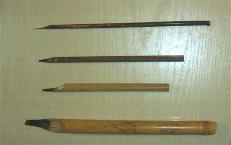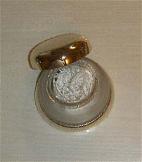Calligraphy Tools Needed for Nastaliq Calligraphy
A professional Nastaliq calligrapher needs quality tools to create master pieces. These tools must have certain characteristics to qualify. It is important for a Nastaliq Calligraphy Artist to understand the relationship between these tools and consider these relationships while using them.
Among these tools, "Reed Pen", "Ink", Paper", and "Writing Pad" play the most critical role. Larger size reed pen requires thinner ink and smoother paper. It may also require the "Writing Pad" to be less rigid to provide the pen with more flexibility and allow it to spin slightly and move on the paper easily.
It is recommended that beginner calligraphy students practice with mid-size reed pen and use plain black ink on plain white paper. The reason behind this recommendation is that this combination of tools, has no decorative extras to distract the eye and reveals all the wrong movements -if any- making them more visible. Therefore, one notices the mistakes and focuses on them. In this way a Nastaliq calligraphy student can improve and enhance his/her calligraphy skills. It must be mentioned that even great calligraphy masters also sometimes apply plain black ink on plain white paper and create master pieces for teaching purposes and to set an example for the students. In this way they can visually follow the Nastaliq curves and learn from the master piece.
List of Persian Calligraphy Tools:
- Nastaliq Calligraphy Pen (Qalam Ney)
- Pen Sharpener (Qalam-Taraash)
- Nib-Finishing Pad (Qat-Zan)
- Ink (Morakkab)
- Ink Container (Davaat)
- Silky Ink-Controller (Liqeh)
- Paper (Kaaqaz)
- Writing Pad (Zir-Dasti)
Note About Nastaliq Calligraphy Pen: Nastaliq calligraphy pen is made of reed/cane or bamboo and depending on the desired size of the pen, it could be made of either one. For small to mid-size pens, special reeds from city of Dezful in Iran are most recommended -Qalam Dezfuli- because of the high density of the reeds and texture of it. It should be mentioned that the reeds must be processed and fully dried prior to being cut and sharpened as calligraphy pen.
Note About Silky Ink-Controller: The ink-controlling silk is a must because in Nastaliq calligraphy the amount of ink that the artist takes each time and the amount of ink that he puts on the paper are very important factors. That is the reason it is necessary to use ink-controlling silk in the inkwell. The second benefit of putting some processed silk (LIQEH) in the inkwell is it prevents any splash of ink outside. It is important to keep the silk in boiling pure water for 10 minutes and then dry it completely prior to putting in into the ink container and filling the container with ink.

Nastaliq Calligraphy Reed Pen (Qalam Ney)


Inkwell with Silk in it
Nib-Finishing Pad and Pen-Sharpener
If you would like to order any Nastaliq calligraphy tools Go to the Nastaliq Calligraphy Book Store